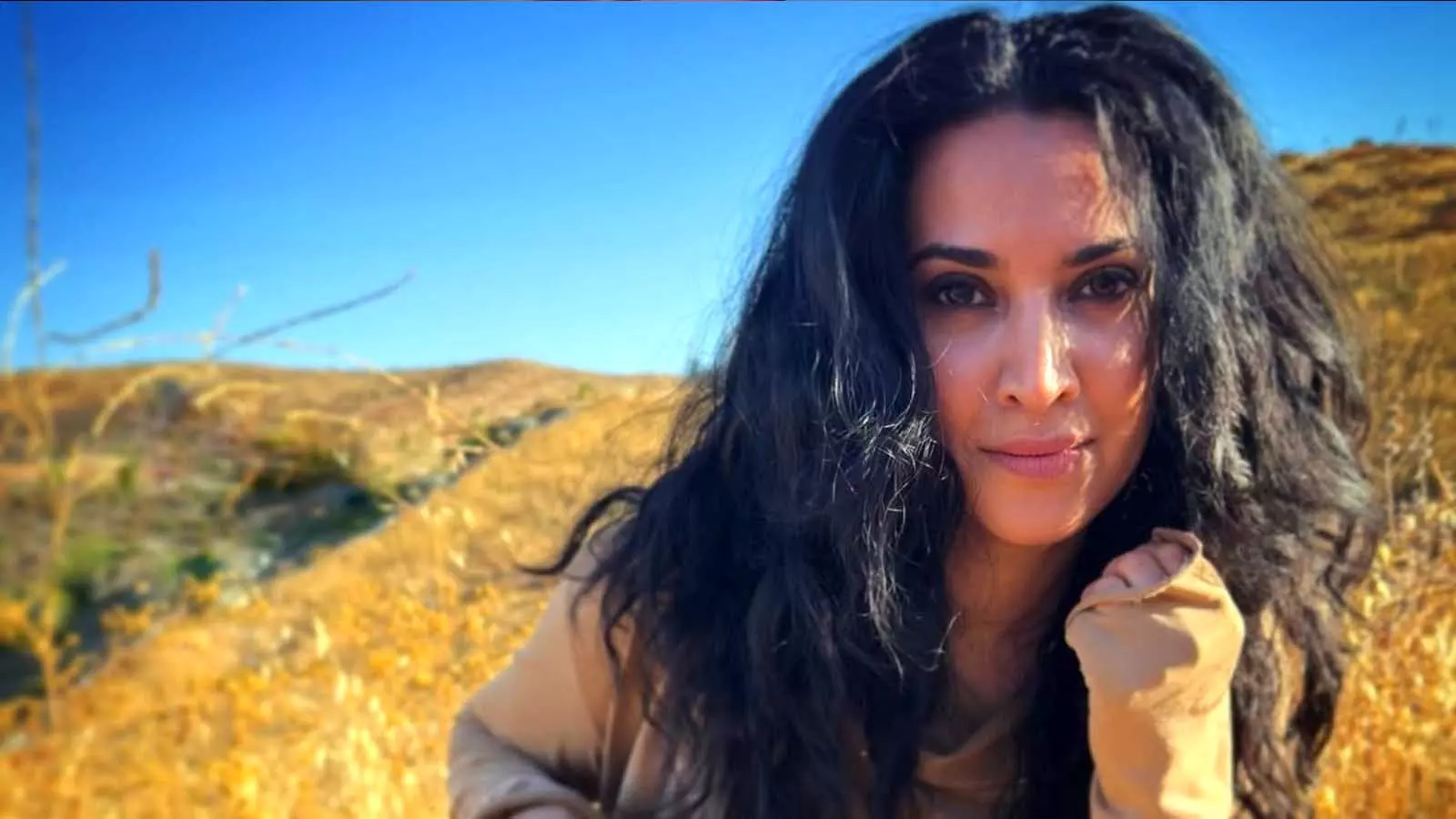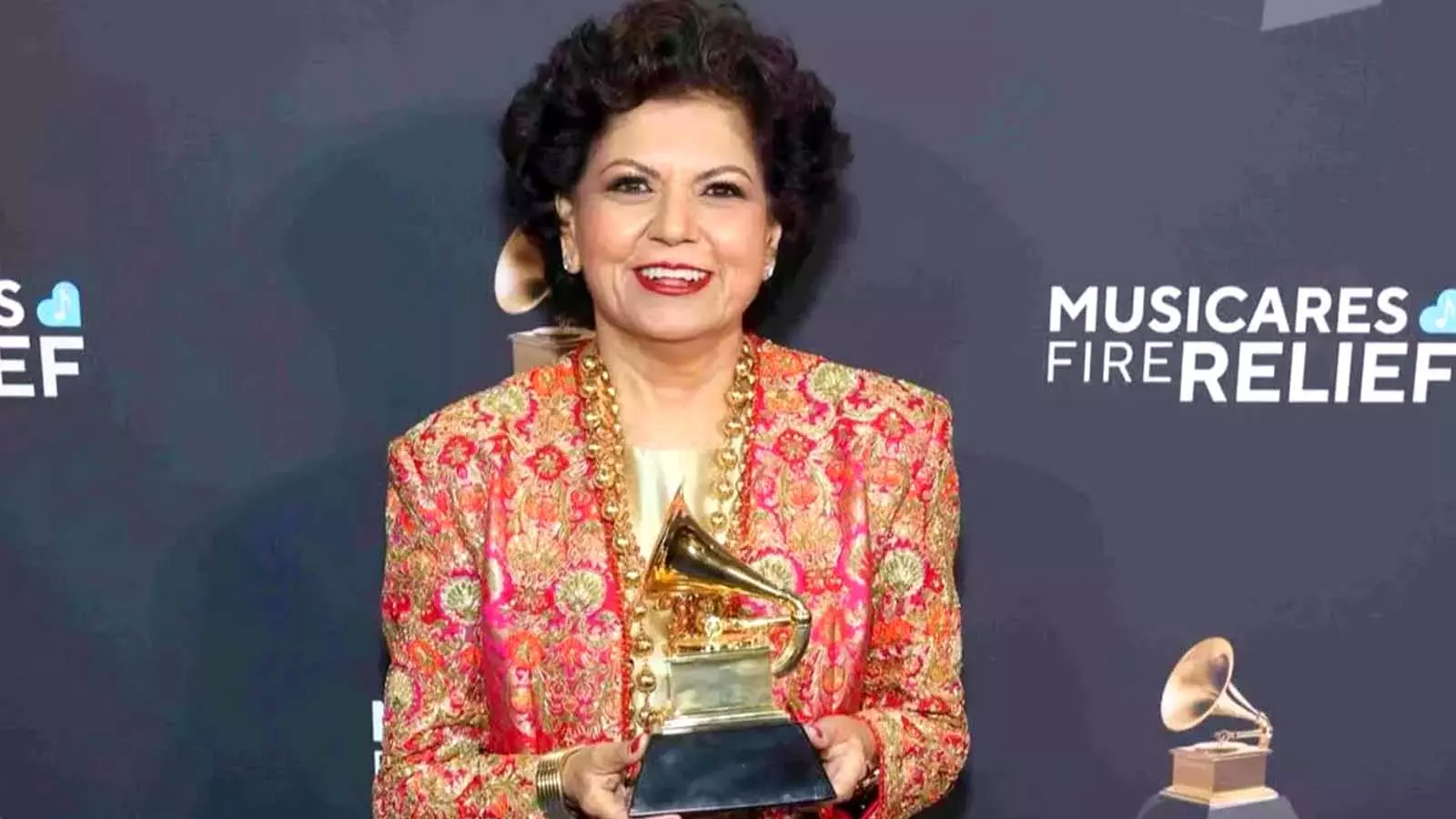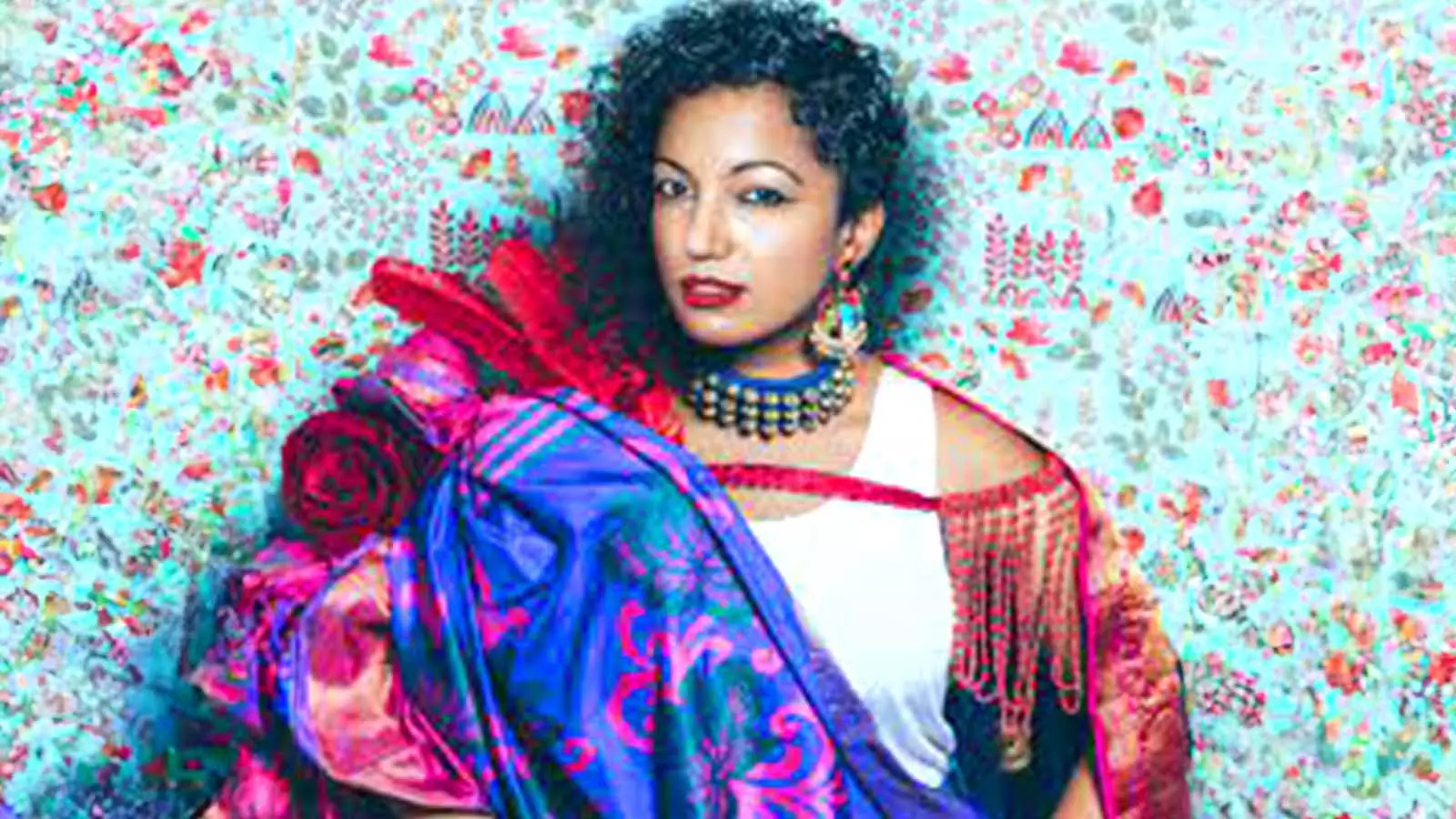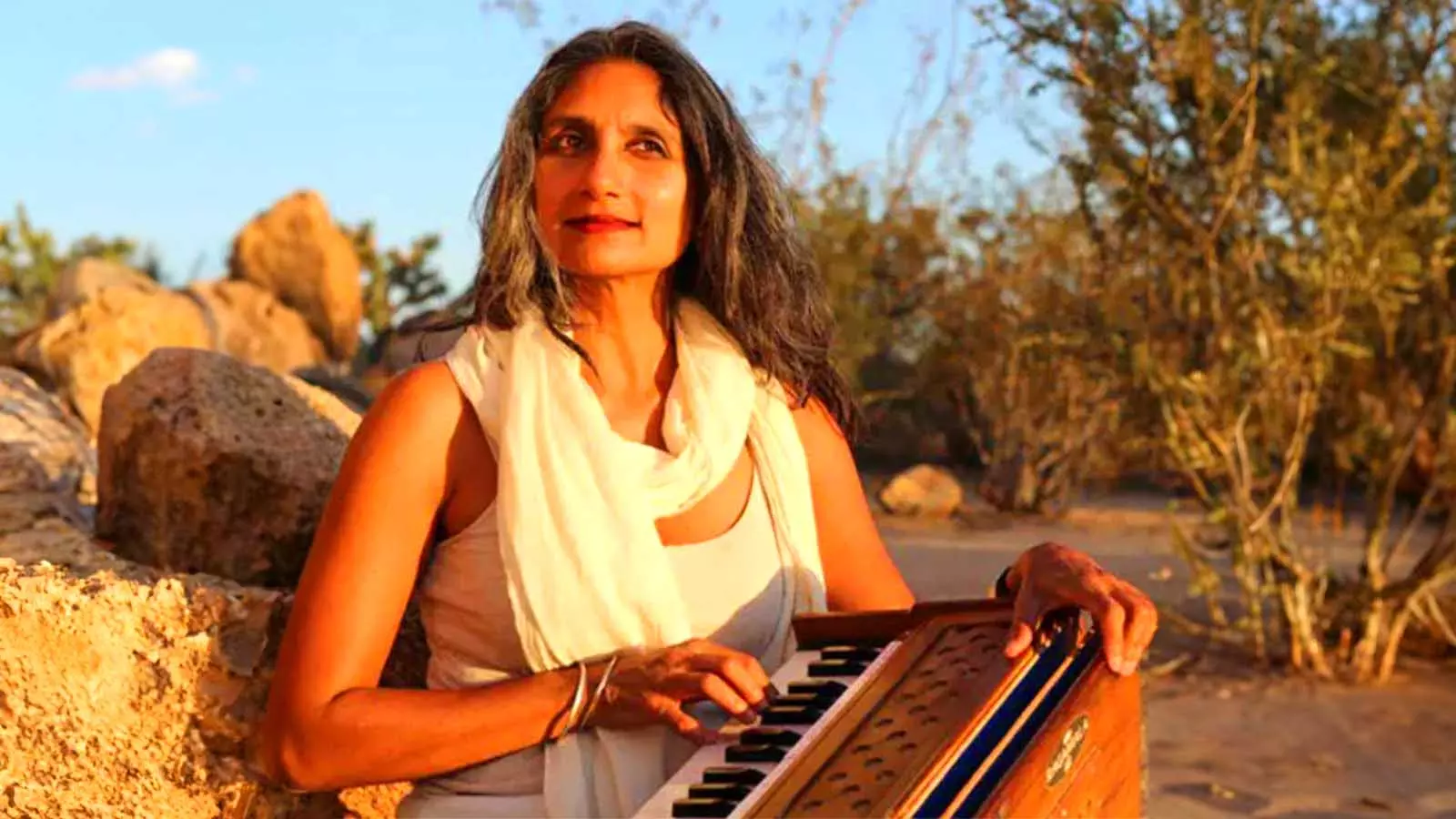
- Home
- India
- World
- Premium
- THE FEDERAL SPECIAL
- Analysis
- States
- Perspective
- Videos
- Sports
- Education
- Entertainment
- Elections
- Features
- Health
- Business
- Series
- In memoriam: Sheikh Mujibur Rahman
- Bishnoi's Men
- NEET TANGLE
- Economy Series
- Earth Day
- Kashmir’s Frozen Turbulence
- India@75
- The legend of Ramjanmabhoomi
- Liberalisation@30
- How to tame a dragon
- Celebrating biodiversity
- Farm Matters
- 50 days of solitude
- Bringing Migrants Home
- Budget 2020
- Jharkhand Votes
- The Federal Investigates
- The Federal Impact
- Vanishing Sand
- Gandhi @ 150
- Andhra Today
- Field report
- Operation Gulmarg
- Pandemic @1 Mn in India
- The Federal Year-End
- The Zero Year
- Science
- Brand studio
- Newsletter
- Elections 2024
- Events
How women musicians of Indian descent are rewriting global soundtrack of devotion

The first wave of Indian music in the West was led primarily by men. Remember sitar maestro Ravi Shankar’s jugalbandi with George Harrison? Or Ali Akbar Khan taking off on global tours with his sarod? Or, more recently, Krishna Das chanting Hanuman Chalisa in packed yoga studios, taking Hindu devotional music or kirtan to the world, and enriching its idea of soul music? The revolution in...
The first wave of Indian music in the West was led primarily by men. Remember sitar maestro Ravi Shankar’s jugalbandi with George Harrison? Or Ali Akbar Khan taking off on global tours with his sarod? Or, more recently, Krishna Das chanting Hanuman Chalisa in packed yoga studios, taking Hindu devotional music or kirtan to the world, and enriching its idea of soul music? The revolution in recent years, however, is unmistakably female. Today’s spiritual wave, led by women singers of Indian descent in the US and the UK, is multilingual, philosophical, and also laced with a South Indian sensibility, especially drawn from Carnatic music, Bhakti poetics, and Vedic chanting traditions.
But before we look at the shift in detail, let’s go a little back in time. It all really began in the late 1700s and 1800s, when British scholars — curious and sometimes condescending — started documenting Indian music as part of their larger orientalist obsession with the “mystical East". They didn’t always get it right, and often reduced ragas to Western scales or treated Indian rhythm as exotic oddities, but the process did spark an interest in Indian music on the foreign shores. Some missionaries wrote treatises, some colonial officers collected folk tunes, and slowly Indian music started appearing in Western academic journals and drawing rooms.
But by the early 20th century, things started to change. Vadodara-born Hazrat Inayat Khan (1882-1927) — a professor of musicology and exponent of the saraswati vina, and a singer, poet and philosopher — became one of the pioneers of the transmission of Sufism to the West.
He founded the Sufi Order in the West and gave lectures and performances that introduced Indian sound as sacred energy. This wasn’t about fusion yet, but it invited the West to sit quietly and listen to something profoundly alive. By the 1960s, Indian classical singers and musicians were performing in concert halls around the world; they were jamming with The Beatles and blowing the minds of hippies in California.
Ravi Shankar became a household name in America and Europe because he played with such emotional power and technical precision that it stunned audiences into worshipping him, idolising him like other icons of genres like rock and roll, blues, rhythm and blues, country, folk or heavy metal. He collaborated with US-born British violinist and conductor Yehudi Menuhin (1916-1999) on a trilogy of albums titled ‘West Meets East’); his teaching of Harrison (which led to The Beatles’ Norwegian Wood and Love You To featuring the sitar), and his historic performance at Woodstock turned ragas into countercultural anthems.
The Concert for Bangladesh — Ravi and George Harrison’s brainchild, held at Madison Square Garden on August 1, 1971, to raise international awareness and funds for refugees from East Pakistan, following the 1971 Bangladesh Liberation War and the 1970 Bhola cyclone — was a massive, star-studded humanitarian concert in which Indian classical music opened for Bob Dylan. Ravi passed the torch to his daughter Anoushka Shankar, who carried it forward with aplomb; developing her own global style by merging classical sitar with electronic, flamenco, and jazz, and collaborating with everyone from Norah Jones (who happens to be her half-sister) to Sting.
Ravi Shankar wasn’t alone. Ali Akbar Khan (1922-2009) — son of the formidable Baba Allauddin Khan, who became the first Indian classical musician to give a solo performance in America in 1955 and went on to found the Ali Akbar College of Music in California, basically setting up a gurukul in the middle of Marin County, where American kids learned taans and talas with the same seriousness as they once did jazz scales — was doing similar work with the sarod. Tabla virtuosos like Alla Rakha Qureshi (1919-2000) and later his son, Zakir Hussain (1951-2024), started accompanying jazz musicians and improvisers, blowing the minds of people who thought rhythm came in 4/4 notes only. Western musicians — John Coltrane, Philip Glass, even The Rolling Stones — began borrowing freely from not just Indian instruments but the very idea of music as meditation, as cosmic rhythm. Fusion was in the air, but it was exploratory. Slowly, Indian music was becoming front and centre in the soundtrack of a changing world.
Since the turn of the 21st century, a new movement has taken shape, moving away from masculine, performative fusion to something more internal, woman-led, chant-based, and spiritual; if the first wave of Indian music abroad was led by men — Ravi, Ali Akbar, Zakir Hussain, L. Subramaniam — then the second wave belongs to women like Chennai-born Chandrika Tandon (Indra Nooyi’s sister), Radhika Vekaria, Sheela Bringi, UAE-based Shilpa Ananth, Nina Rao, and many others, whose music often draws from chants, Vedic mantras, and Carnatic or Hindustani ragas, but feels looser, more fluid, designed for meditation, yoga, healing, reflection.
Vekaria, who was nominated for the 67th Grammy Awards held in February this year, never intended to make mantra music. She resisted it for years. “I was asked to record mantra-inspired music for a long time,” she told The Federal earlier this year, “but I didn’t feel ready.” Then something changed. The resistance turned into readiness. A call that was always there finally came to the fore. In October 2020, she recorded and released her first artist album called SAPTA: The Seven Ways, which combines traditional mantras and devotional songs for the modern world. Her Grammy-nominated second album Warriors of Light (2024) continues in the same terrain. Vekaria — who grew up listening to devotional bhajans in the UK and trained in classical Western composition — uses Sanskrit mantras to take you to a plane of consciousness. “Sanskrit mantras smash the unreal, reveal what’s real,” she told me.

Vekaria grew up listening to devotional bhajans in the UK and trained in classical Western composition.
If Vekaria is the fierce warrior, Chandrika Tandon is the calm oracle. She’s not your typical Grammy-winning (for Triveni; chants-meets-world music) artist. Tandon spent decades as a business executive and is now a philanthropist, educator, and vocalist who sings Sanskrit mantras with the conviction of someone who’s tasted both boardroom pressure and transcendental peace. Her 2009 album Soul Call was recorded as a personal offering — a musical gift for her father-in-law — but te project took on a life of its own. The centerpiece of the album is the chant “Om Namo Narayanaya", repeated 90 times over 40 minutes.
“Music has a way of getting into your soul,” Tandon told The Federal when she won the award this year. Her follow-up albums — including Shivoham: The Quest and Ammu’s Treasures — are designed to build bridges between traditions, cultures, and generations. Her work is now part of education programmes, spiritual retreats, and public concerts around the world. She often collaborates with top-tier classical instrumentalists — including South Indian mridangam and veena artists — to bring gravitas to the chants. But more than her music, it’s her life story — moving from Wall Street to Vedic street — that’s inspiring a generation of artists.

Chandrika Tandon spent decades as a business executive and is now a philanthropist, educator, and vocalist who sings Sanskrit mantras.
Bringi, the Indian-American singer, harpist, and bansuri (bamboo flute) player, is steeped in Indian classical traditions which she combines with Western sounds in a soft, soulful, and spiritual way. She grew up in a household surrounded by Indian devotional music — bhajans, chants, and ragas — and later trained in both Hindustani classical music and jazz. This gave her a rare, rich combination of East and West in her musical vocabulary. Her albums, like Shakti Sutra and Incantations, are known for their meditative dimension. She uses Sanskrit mantras, ancient Vedic chants, and soft electronic textures, along with the harp and flute, to create music. Whether she’s singing a mantra or improvising on the flute, Sheela’s music invites listeners into a gentle, sacred space that honours Indian traditions while still speaking the language of the modern world.

Sheela Bringi’s music invites listeners into a gentle, sacred space that honours Indian traditions.
Shilpa Ananth, one of the most exciting Indian-origin artists in global music right now, was born in Dubai to parents from Kerala, and grew up surrounded by a mix of sounds — her mother introduced her to South Indian classical music, while her brother played her jazz, hip-hop, and R&B. She was drawn to the voices of Norah Jones, Ella Fitzgerald, and Nina Simone, among others, and today, she’s known for making smooth, soulful mixes of Indian ragas, with strains of jazz, electronica, and even Arabic music. She sings in multiple languages — Tamil, Malayalam, Hindi, Arabic, and English — and somehow makes it all feel seamless.
After graduating from Berklee College of Music with honours, Shilpa released her debut EP Indian Soul in 2015. It was a personal, genre-bending project that really got attention. Since then, she’s collaborated with big names like AR Rahman, Bobby McFerrin, and Javier Limón. In 2023, she released a new EP called Reproduction, which is all about creation, self-discovery, and feminine power. The music video for her song “The Search” won a Platinum Award, and she’s also a faculty member at Berklee’s Abu Dhabi campus.

Shilpa Ananth's mother introduced her to South Indian classical music, while her brother played her jazz, hip-hop, and R&B.
Brooklyn (NY)-based kirtan singer Nina Rao was born in Bekal, a village in Kerala, and learned chanting from her grandfather when she visited his village as a child. But her real journey into spiritual music began much later — in 1996, when she started working with Krishna Das, one of the most well-known Western kirtan singers. Since then, she’s become a familiar face in the global chanting community; she often performs with him but also does her own solo work. In 2013, Nina released her first album Antarayaami – Knower of All Hearts, a double CD full of traditional chants, including several versions of the Hanuman Chalisa. Her second album, Anubhav, came out in 2018, and was funded entirely by her supporters.

Kirtan singer Nina Rao was born in Bekal, a village in Kerala, and learned chanting from her grandfather when she visited his village as a child.
These women — with roots across Kerala, Tamil Nadu, Dubai, London, Chennai, Brooklyn — are scripting a new chapter of Indian music in the West. By their refusal to be flattened into the consumability of fusion, these artists, who are scattered across continents but linked by memory, migration, and a kind of shared cultural static, are making music layered with histories. Music that bends time, lets language echo and fray, loops fragments until they feel like invocation.
They are also changing what world music can mean in 2025: an open-ended conversation between artists and geographies, between the self and its unresolved pasts. When I asked Vekaria what her music meant to her, she said it was her ‘lifeline, a means of survival, and a form of love.’ She also told me how discovering the 3,500-year-old Tamil composition, Aganitha Tara, led her down a fascinating journey. “Sanskrit is home,” she said. Perhaps for all these women, chants or bhajans and kirtans mean the same: A home away from home. A home with a window into the world. A home that heals.
